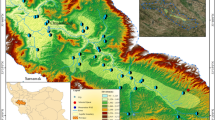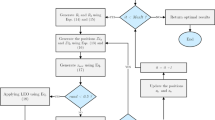Abstract
This research investigates the capabilities of four data-driven models, namely artificial neural network, wavelet-based artificial neural network (WANN), gene expression programming, and support vector machine, to predict water quality parameter, i.e., sodium absorption ratio (SAR) of the groundwater of the Ardabil plain, Ardabil Province, Iran. A combination of data sets including electrical conductivity, total dissolved solids, and sodium was considered as input data of the models. The models’ performances were compared with the classical multiple linear regression model. The models were calibrated and validated using the measured quality data for the period of year 2005 to 2015. The performance of the models was evaluated using various statistical criteria, scatter, and PDF plots. Results showed that the data-driven models are more capable in simulating the SAR data than the classical multiple linear regression model. The WANN model provided reliable predictions of the SAR values rather than the other models.






Similar content being viewed by others
Availability of data and material (data transparency)
The datasets used in this study were compiled from the Regional Water Organization in Iran. They are available from the corresponding author upon reasonable request.
Code availability
The code generated in this study is available from the corresponding author on reasonable request.
References
Abrahart R et al (2008) Data-driven modelling: concepts, approaches and experiences, practical hydroinformatics. Water science and technology library. Springer, Berlin, Heidelberg, pp 17–30
Addison PS, Murrary KB, Watson JN (2001) Wavelet transform analysis of open channel wake flows. J Eng Mechan 127:58–70
Dawson CW, Robert W (1998) An artificial neural network approach to rainfall-runoff modelling. Hydrol Sci J 43(1):47–66
Deo RC, Kisi O, Singh VP (2017a) Drought forecasting in eastern Australia using multivariate adaptive regression spline, least square support vector machine and M5Tree model. Atmos Res. https://doi.org/10.1016/j.atmosres.2016.10.004
Deo RC, Tiwari MK, Adamowski JF, Quilty MJ (2017b) Forecasting effective drought index using a wavelet extreme learning machine (W-ELM) model. Stoch Environ Res Risk Assess 31(5):1211–1240
Dogan E, Sengorur B, Koklu R (2009) Modeling biological oxygen demand of the Melen River in Turkey using an artificial neural network technique. J Environ Manag 90:1229–1235
El-Shafie A, Jaafer O, Seyed A (2011) Adaptive neuro-fuzzy inference system based model for rainfall forecasting in Klang River, Malaysia. Int J Phys Sci 6(12):2875–2888
Ghorbani MA, Deo RC, Karimi V, Kashani MH, Ghorbani S (2019) Design and implementation of a hybrid MLP-GSA model with multi-layer perceptron-gravitational search algorithm for monthly lake water level forecasting. Stoch Environ Res Risk Assess 33(1):125–147
Goyal MK, Bharti B, Quilty J, Adamowski J, Pandey A (2014) Modeling of daily pan evaporation in sub tropical climates using ANN, LS-SVR, fuzzy Logic, and ANFIS. Expert Syst Appl 41(11):5267–5276. https://doi.org/10.1016/j.eswa.2014.02.047
Hasanpour Kashani M, Daneshfaraz R, Ghorbani MA, Najafi MR, Kisi O (2015) Comparison of different methods for developing a stage–discharge curve of the Kizilirmak River. J Flood Risk Manag 8(1):71–86
Kashani MH, Ghorbani MA, Shahabi M, Naganna SR (2020) Multiple AI model integration strategy—application to saturated hydraulic conductivity prediction from easily available soil properties. Soil Tillage Res 196:104449
Khadr M, Elshemy M (2017) Data-driven modeling for water quality prediction case study: the drains system associated with Manzala Lake, Egypt. Ain Shams Eng J 8(4):549–557
Khadr M, Schlenkhof A (2014) Integration of data-driven modeling and stochastic modeling for multi-purpose reservoir simulation. In: 11th international conference on hydroscience and engineering (ICHE2014), Hamburg, Germany
Khatibi R, Ghorbani MA, Kashani MH, Kisi O (2011) Comparison of three artificial intelligence techniques for discharge routing. J Hydrol 403(3–4):201–212
Kişi O, Cimen M (2009) Evapotranspiration modelling using support vector machines/Modélisation de l’évapotranspiration à l’aide de ‘support vector machines.’ Hydrol Sci J 54(5):918–928
Labat D, Ababou R, Mangin A (2000) Rainfall–runoff relation for karstic spring. Part 2: Continuous wavelet and discrete orthogonal multi resolution analyses. J Hydrol 238:149–178
Malik A, Kumar A, Ghorbani MA, Kashani MH, Kisi O, Kim S (2020) The viability of co-active fuzzy inference system model for monthly reference evapotranspiration estimation: case study of Uttarakhand State. Hydrol Res 50(6):1623–1644
Meyer Y (1993) Wavelets, algorithms and applications. Society for Industrial and Applied Mathematics, Philadelphia
Nash JE, Sutcliffe JV (1970) River flow forecasting through conceptual models part 1—a discussion of principles. J Hydrol 10(3):282–290
Nouraki A, Alavi M, Golabi M et al (2021) Prediction of water quality parameters using machine learning models: a case study of the Karun River, Iran. Environ Sci Pollut Res 28:57060–57072
Orouji H, Orouji H, Bozorg Haddad O, Fallah-Mehdipour E (2013) Modeling of water quality parameters using data-driven models. J Environ Eng ASCE 139:947
Rankovic V, Radulovic J, Radojevic I, Ostojic A, Comic L (2010) Neural network modeling of dissolved oxygen in the Gruza reservoir, Serbia. Ecol Model 221:1239–1244
Ravansalar M, Rajaee T, Ergil M (2016) Prediction of dissolved oxygen in River Calder by noise elimination time series using wavelet transform. J Exp Theor Artif Intell 28(4):689–706
Sepahvand A, Singh B, Sihag P, Nazari Samani A, Ahmadi H, Fiz Nia S (2019) Assessment of the various soft computing techniques to predict sodium absorption ratio (SAR). ISH J Hydraul Eng 1–12.
Shrestha BP, Duckstein LE, Stokhin Z (1996) Fuzzy rule-based modeling of reservoir operation. J Water Resour Plan Manag 122(4):262–269
Sudheer KP, Jain SK (2003) Radial basis function neural network for modeling rating curves. ASCE J Hydrol Eng 8(3):161–164
Vapnik VN (1995) The nature of statistical learning theory. Springer 8:188. https://doi.org/10.1109/TNN.1997.641482
Funding
No funds, grants, or other support was received.
Author information
Authors and Affiliations
Contributions
Conceptualization, writing—review and editing—were performed by MHK, methodology, formal analysis, and investigation by MRN, data collection and data analysis by RJ, and all authors read and approved the final manuscript.
Corresponding author
Ethics declarations
Conflict of interest
The authors confirm that the content of this article has no conflicts of interest.
Ethics approval
This article does not contain any studies with human participants or animals performed by any of the authors.
Consent to participate
Not applicable.
Consent for publication
Not applicable.
Additional information
Publisher's Note
Springer Nature remains neutral with regard to jurisdictional claims in published maps and institutional affiliations.
Rights and permissions
Springer Nature or its licensor (e.g. a society or other partner) holds exclusive rights to this article under a publishing agreement with the author(s) or other rightsholder(s); author self-archiving of the accepted manuscript version of this article is solely governed by the terms of such publishing agreement and applicable law.
About this article
Cite this article
Hasanpour Kashani, M., Nikpour, M.R. & Jalali, R. Water quality prediction using data-driven models case study: Ardabil plain, Iran. Soft Comput 27, 7439–7448 (2023). https://doi.org/10.1007/s00500-022-07684-7
Accepted:
Published:
Issue Date:
DOI: https://doi.org/10.1007/s00500-022-07684-7




